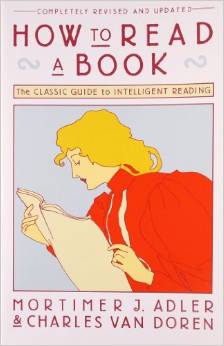In keeping with the idea that “September is a great time to learn a few new things,” I just read the first part of How to Read a Book: The Classic Guide to Intelligent Reading. And yes, I’ve read about a zillion books in my lifetime, but why not see if there’s more to learn about getting the most from a really great book?
A few notes from reading Section 1…

- Why read? Basically, we read for entertainment, information, or understanding. This book is all about the art of reading for increased understanding.
- Reading for understanding requires effort. It’s not the falling-asleep-while-reading-a-novel that we sometimes do to relax.
- Guess what? There’s more to learn about reading. Most of us don’t learn enough about how to read well in school.
- Also, it’s possible to misread books: to read widely, but not well. To be a “bookful blockhead.” (Ouch.)
- How is reading like baseball? The writer throws the ball and the reader catches it (great analogy). Both of these require active participation and skill.
- Quick overview of the four levels of reading:
- Elementary Reading. Beginning literacy. Reading the words.
- Inspectional Reading. Skimming & pre-reading with purpose. Even many good readers don’t do this.
- Analytical Reading. Intensely active, question-asking, chewing-and-digesting reading for understanding.
- Syntopical Reading. Comparing multiple sources and creating a new synthesis from what you’ve read.
- Inspectional reading sets the stage for taking a deeper dive later. It has two parts:
- Systematic Skimming or Pre-Reading. Do I really want to read this book? Is it worth a deeper dive? What’s the general theme? What are the big ideas? What’s the structure of the book? There are 6 steps for this, and they go quickly.
- Superficial Reading. Read the book quickly. Don’t stop to look things up or puzzle out difficult concepts. Breeze through. Don’t wrap yourself around the first tree that gets in your way; instead, get a sense of the whole forest.

- The last chapter in Section 1 is about being a “demanding reader” by asking questions and taking notes.
- There’s a delightful summary about learning complex skills (like reading well).
- They also have a motivational section that says:
- When you want to read for deeper understanding, you’ll find their system for reading well worth it. (They point out the value.)
- Reading well is likely harder than you think it is. (Not too easy.)
- You can learn it, step-by-step. (You can use proximal goals to help you.)
- Even though there’s a lot of effort involved, you can do it! (Not too hard.)
I’m enjoying this book. For me, the section on superficial reading was great. I already do some of what they suggest, but I can see room for improvement. At the same time, I sometimes stop after one quick read even when I’d benefit from a more analytical approach. So I’m looking forward to reading the next section, which is all about Analytical Reading.
What do you think? Do we rush through everything without enough attention? Are there some books (or other writings) that we’d do well to read more thoroughly? Is it worth brushing up on our reading skills?
Resources
Post | Yes, You Can Learn This
Book | How to Read a Book
